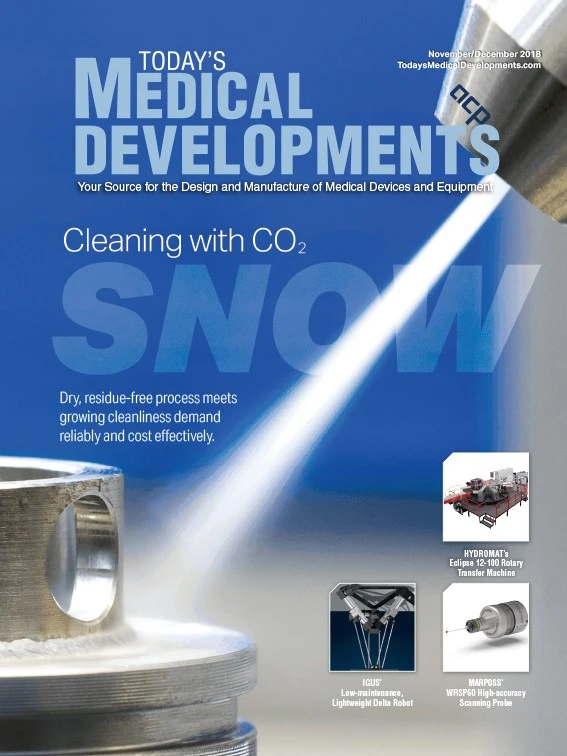
Randy Glover, project manager at Fredon Corp., is a bit of a technology enthusiast, which helps him find solutions for challenges encountered at work.
Fredon has been in business since 1969, machining difficult-to-make parts for the medical, aerospace, transportation, and electronics industries. The company’s objective, “one step beyond,” means constantly striving for the goals of lean manufacturing, continuous improvement, precision, and operational excellence.
The company started in Euclid, Ohio, with a two-man team in a 1,800ft2 facility and today operates out of a 70,000ft2, climate-controlled facility in Mentor, Ohio.
“A consistent goal of ours is to remain at the front of the manufacturing world,” Glover states, “to be able to provide our customers with high-quality parts manufactured in innovative ways. Fredon is small enough to keep a one-on-one relationship with our customers and skilled enough to surpass the expectations of a facility many times larger [than ours].”
Machinists at Fredon use turning, milling, grinding, 4-axis, and 5-axis equipment, and with so many capabilities and a commitment to customers, downtime is not an option.

Quick, easy solution
“The process of having to load and unload our CNC programs was inefficient,” Glover says. “It varied from machine to machine, and most times, it was a nightmare. I had to find a quick and easy solution that could be used by all team members, regardless of technical ability.”
There are close to 100 employees at Fredon and a big percentage of them have been working there for more than 25 years, when technology was not as frequently used at the machines. Floppy disks were still around, paper tape was still in use, and CNCs – such as the Haas VF-1 vertical machining center (VMC) – were still a new concept. Glover wanted to make sure everyone on the shop floor could easily use any solution he chose for the machines.
Glover began looking for an USB interface for his old RS232-based machines. He was considering upgrading systems to USB through proprietary hardware, installed directly by the machine manufacturer, but the price was too high. That’s when he came across Shop Floor Automations’ Portable USB Connect unit, and going that route was a “no-brainer,” Glover says, because of the affordability compared to the alternative.
The Portable USB Connect communication device can load and save programs from CNC memory and drip-feed to most CNC machines. It contains its own DNC firmware, doesn’t require other devices or components to work, and is a standalone DNC transfer box solution.

“It definitely saved us a lot of time, a lot of money, from having to run around and do it with a laptop, especially on a lot of the older units that have the floppy drives in them, or the PCMCIA cards. They kind of died out, so it was definitely a big help for us,” Glover says.
The device can also back up a DNC Network if it goes down or is used as the primary input device in a CNC shop. It supports high-speed data transfer and works on most CNC controls that support standard serial protocols.
To drip-feed large files from the USB Connect, users connect the unit, select DNC, and press cycle start on the CNC.
A few years later
Glover still finds several uses for the Portable USB Connect that he bought in 2016, and he’s invested in two Floppy Drive Emulators and a Pendant USB Connect.
The USB Floppy Drive Emulator replaces the machine’s existing floppy drive with an independently operated USB flash drive reader. Besides removing the existing drive and replacing it with the Emulator, no additional system configuration or debugging is required. The drive replaces most existing 720k/1.44MB capacity 28- or 34-pin ribbon-cable systems and will connect to the machine’s existing power and data cables.
The USB Connect Pendant Mount includes a 2GB USB flash drive stick, panel-mount USB connector/waterproof cap, display, USB cable, and a power cable. It becomes part of the CNC control without cabling or power.
“The Shop Floor Automations Floppy Drive Emulator and USB upgrades have saved us an uncalculatable amount of time in transferring programs to and from CNC machines,” Glover says. “It really helped with some of the older machines that were crabby when it came to using the RS232 with a dated DNC system.”

Glover adds that setting up the hardware was “very intuitive for some of our more seasoned machinists who are not super tech-savvy.”
Bridging the gap between old and new technology in Fredon’s shop mirrors Fredon’s need to bridge the skills gap as manufacturing technology evolves.
Referring to a picture of him and his father, Glover says, “He was working here [Fredon] my entire life. If it wasn’t for him working here, I never would have worked here, and never would have been in the position to purchase anything from Shop Floor Automations.”
Fredon Corp.
http://www.fredon.com
Shop Floor Automations
https://www.shopfloorautomations.com

Explore the November December 2018 Issue
Check out more from this issue and find your next story to read.
Latest from Today's Medical Developments
- Teleflex sells acute care and urology businesses for $2.03 billion
- HANNOVER MESSE: Where research and manufacturing meet
- What’s next for the design and manufacturing industry in 2026?
- Arcline to sell Medical Manufacturing Technologies to Perimeter Solutions
- Decline in German machine tool orders bottoming out
- Analysis, trends, and forecasts for the future of additive manufacturing
- BlueForge Alliance Webinar Series Part III: Integrate Nationally, Catalyze Locally
- Robot orders accelerate in Q3





